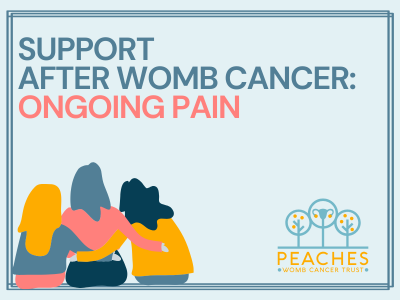Ongoing pain and discomfort are a common concern for many women following treatment for womb cancer. This can be difficult to cope with, not only physically, but also emotionally as it naturally raises concerns regarding recurrence. It is important to recognise that this is a normal response as we know pain can be a symptom of recurrence, however we also know that there are other reasons why pain and discomfort is experienced following treatment.
Ongoing pain can have a significant impact on quality of life and understanding the possible cause of pain and coping mechanisms in relation to this can help. Pelvic pain can present itself in different ways. Some women may experience a dull ache or pressure in the pelvic area, while others may feel sharp, shooting pains. The pain may be constant or intermittent and may worsen with certain activities such as sitting or standing for long periods. Other symptoms of pelvic pain after treatment for womb cancer may include pain during sexual intercourse, difficulty urinating or when having a bowel movement. If you experience any of these symptoms, if you have a new pain that you have not experienced before, pain worsens or bowel and bladder habits change it is important to talk to your GP or Clinical team, as it may indicate a more serious underlying condition.
There are many possible causes of pain and perhaps the most common cause is the impact of the surgery to the surrounding pelvic organs. Many women with a womb cancer diagnosis undergo surgery that involves removing the womb, fallopian tubes, ovaries, and lymph nodes. As a result pain and inflammation in the pelvic area can occur and last for several weeks or months for some women. Adhesions and scar tissue will also form as part of the healing process and can account for discomfort and altered sensation.
If radiotherapy is part of your treatment there may be some damage to the pelvic organs which can cause inflammation and pain. Alongside pain, common associated symptoms include vaginal dryness, itching and burning. Chemotherapy drugs can also result in inflammation during and after treatment and may also be associated with nausea, vomiting and diarrhoea.
If you are struggling with pelvic pain after womb cancer, you are not alone. There are many women who experience discomfort, which can range from mild to severe, and can have a significant impact on daily life.
Below we have put together some suggestions to try and help:
- Talk to your clinical team as they may be able to help you understand the reason for the pain and suggest treatments such as pain relief medication or offer a referral to women’s health physiotherapy.
- Avoid constipation by eating a healthy diet and drinking plenty of fluids.
- Practice relaxation techniques such as deep breathing, meditation, or yoga as pelvic pain can be exacerbated by stress and tension.
- Exercise regularly if possible, such as a regular walk with friends. This will improve circulation and promote muscle relaxation. If you are unsure about whether you can exercise and what is suitable, please talk to your clinical team.
- A warm bath or hot water bottle can soothe muscles and reduce discomfort
- Join a support group. Peaches offer monthly virtual coffee morning and evening support groups. This is an opportunity to listen, talk and share your experiences with other women who have experienced womb cancer. We hope this can provide emotional support and you may get some practical tips for managing your pain. Find out more here.
If pain continues to be a concern and is having a significant impact on everyday life, or you experience new pain, it is important to have this investigated either with your clinical team or your GP who can refer appropriately.
It may be useful to keep a pain diary, noting information such as:
- How bad is the pain?
- How long does it last?
- Is the pain in one place or several places?
- Can you pinpoint where the pain is?
- Can you describe the pain – is it burning, sharp, stabbing or is it more of an ache?
- What makes the pain better or worse, for example is it worse when moving or at rest?
This information will help your clinician’s assessment and plan investigations and/or recommend treatment.
Further information and support can be found at your local Maggie’s centre, where you can learn strategies to manage your pain, and speak with others about your experiences.


